For the 2025 school year, there are 3 public schools serving 970 students in White Mountains Regional School District. This district's average testing ranking is 2/10, which is in the bottom 50% of public schools in New Hampshire.
Public Schools in White Mountains Regional School District have an average math proficiency score of 25% (versus the New Hampshire public school average of 41%), and reading proficiency score of 38% (versus the 51% statewide average).
Minority enrollment is 8% of the student body (majority Hispanic), which is less than the New Hampshire public school average of 18% (majority Hispanic).
Overview
This School District
This State (NH)
# Schools
3 Schools
508 Schools
# Students
970 Students
165,155 Students
# Teachers
95 Teachers
14,445 Teachers
Student : Teacher Ratio
10:1
10:1
District Rank
White Mountains Regional School District, which is ranked within the bottom 50% of all 189 school districts in New Hampshire (based off of combined math and reading proficiency testing data) for the 2021-2022 school year.
The school district's graduation rate of 85-89% has stayed relatively flat over five school years.
Overall District Rank
#170 out of 189 school districts
(Bottom 50%)
(Bottom 50%)
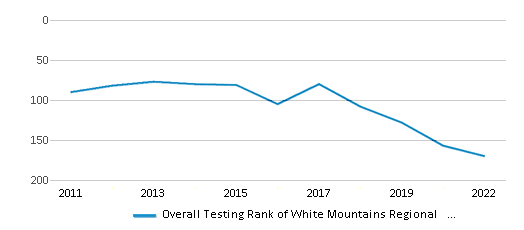
Math Test Scores (% Proficient)
25%
40%
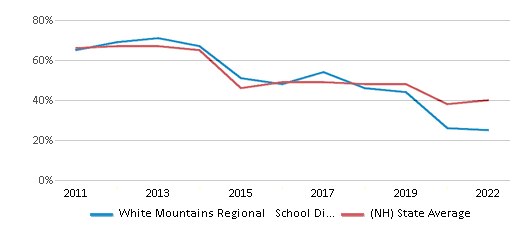
Reading/Language Arts Test Scores (% Proficient)
38%
51%
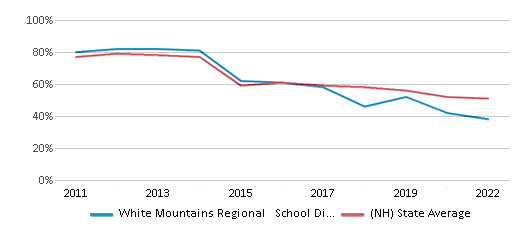
Science Test Scores (% Proficient)
31%
36%
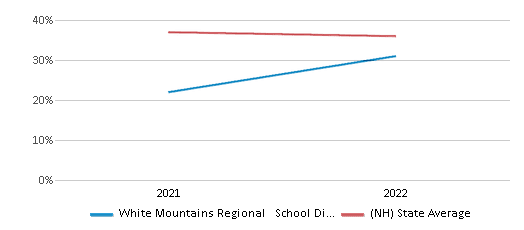
Graduation Rate
85-89%
88%
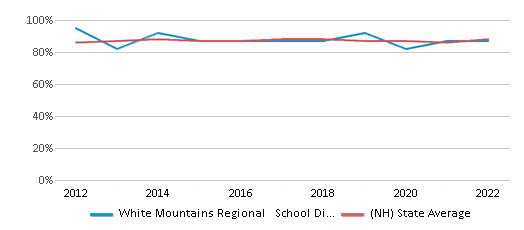
Students by Ethnicity:
Diversity Score
0.15
0.32
# American Indian Students
n/a
308 Students
% American Indian Students
n/a
n/a
# Asian Students
11 Students
4,993 Students
% Asian Students
1%
3%
# Hispanic Students
25 Students
12,212 Students
% Hispanic Students
3%
8%
# Black Students
2 Students
3,437 Students
% Black Students
n/a
2%
# White Students
893 Students
135,947 Students
% White Students
92%
82%
# Hawaiian Students
n/a
133 Students
% Hawaiian Students
n/a
n/a
# Two or more races Students
39 Students
8,195 Students
% of Two or more races Students
4%
5%
Students by Grade:
# Students in PK Grade:
42
4,442
# Students in K Grade:
49
10,942
# Students in 1st Grade:
57
11,733
# Students in 2nd Grade:
59
12,179
# Students in 3rd Grade:
77
12,078
# Students in 4th Grade:
66
12,182
# Students in 5th Grade:
68
12,522
# Students in 6th Grade:
49
11,957
# Students in 7th Grade:
65
12,326
# Students in 8th Grade:
68
12,086
# Students in 9th Grade:
86
13,698
# Students in 10th Grade:
107
13,269
# Students in 11th Grade:
68
13,028
# Students in 12th Grade:
109
12,713
# Ungraded Students:
-
-
District Revenue and Spending
The revenue/student of $25,321 is higher than the state median of $22,075. The school district revenue/student has stayed relatively flat over four school years.
The school district's spending/student of $23,676 is higher than the state median of $21,293. The school district spending/student has stayed relatively flat over four school years.
Total Revenue
$25 MM
$3,646 MM
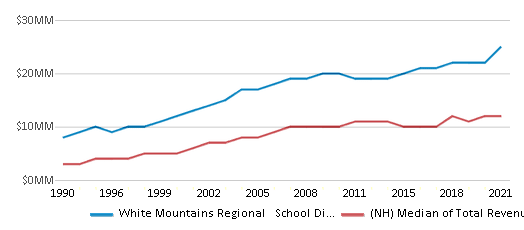
Spending
$23 MM
$3,517 MM
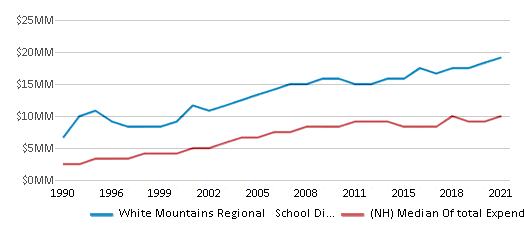
Revenue / Student
$25,321
$22,075
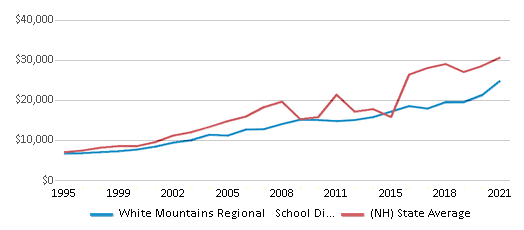
Spending / Student
$23,676
$21,293
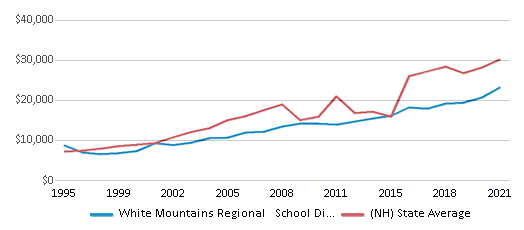
Best White Mountains Regional School District Public Schools (2025)
School
(Math and Reading Proficiency)
(Math and Reading Proficiency)
Location
Grades
Students
Rank: #11.
Whitefield Elementary School
(Math: 30-34% | Reading: 40-44%)
Rank:
Rank:
3/
Bottom 50%10
34 Twin Mountain Rd.
Whitefield, NH 03598
(603) 837-3088
Whitefield, NH 03598
(603) 837-3088
Grades: PK-8
| 278 students
Rank: #22.
Lancaster Elementary School
(Math: 24% | Reading: 35%)
Rank:
Rank:
2/
Bottom 50%10
35 Ice Pond Road
Lancaster, NH 03584
(603) 788-4924
Lancaster, NH 03584
(603) 788-4924
Grades: PK-8
| 322 students
Rank: #33.
White Mountains Regional High School
(Math: 10-14% | Reading: 40-44%)
Rank:
Rank:
2/
Bottom 50%10
127 Regional Rd.
Whitefield, NH 03598
(603) 837-2528
Whitefield, NH 03598
(603) 837-2528
Grades: 9-12
| 370 students
Frequently Asked Questions
How many schools belong to White Mountains Regional School District?
White Mountains Regional School District manages 3 public schools serving 970 students.
What is the rank of White Mountains Regional School District?
White Mountains Regional School District is ranked #168 out of 189 school districts in New Hampshire (bottom 50%) based off of combined math and reading proficiency testing data for the 2021-2022 school year.
What is the racial composition of students in White Mountains Regional School District?
92% of White Mountains Regional School District students are White, 4% of students are Two or more races, 3% of students are Hispanic, and 1% of students are Asian.
What is the student/teacher ratio of White Mountains Regional School District?
White Mountains Regional School District has a student/teacher ratio of 10:1, which is lower than the New Hampshire state average of 11:1.
What is White Mountains Regional School District's spending/student ratio?
The school district's spending/student of $23,676 is higher than the state median of $21,293. The school district spending/student has stayed relatively flat over four school years.
Recent Articles

What Is A Charter School?
Explore the world of charter schools in this comprehensive guide. Learn about their history, how they operate, and the pros and cons of this educational innovation. Discover key facts about charter schools, including admission policies, demographics, and funding, as well as what to look for when considering a charter school for your child.

10 Reasons Why High School Sports Benefit Students
Discover the 10 compelling reasons why high school sports are beneficial for students. This comprehensive article explores how athletics enhance academic performance, foster personal growth, and develop crucial life skills. From improved fitness and time management to leadership development and community representation, learn why participating in high school sports can be a game-changer for students' overall success and well-being.

February 05, 2025
Understanding the U.S. Department of Education: Structure, Impact, and EvolutionWe explore how the Department of Education shapes American education, from its cabinet-level leadership to its impact on millions of students, written for general audiences seeking clarity on this vital institution.





